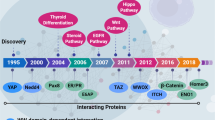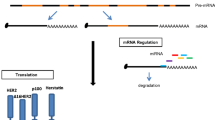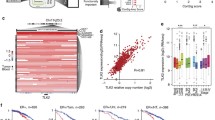Abstract
DNA-dependent protein kinase catalytic subunit (DNA-PKcs) has emerged as a regulator of carcinogenesis. Increased expression of DNA-PKcs correlates with metastatic cancers. Here we review recently reported crosstalk of DNA-PKcs with estrogen (ER), progesterone (PR) and epidermal growth factor (EGFR) receptors. The reports show an extensive network of functional and direct interactions. Targeted studies focused on specific molecular mechanisms, and a systems biology network analysis shows unbiasedly engagement of various cellular functions. Feedforward regulation between expression and activities of DNA-PKcs and ER, DNA-PKcs-dependent phosphorylation of PR and an impact on PR-dependent transcription, and DNA-PKcs-promoted EGFR-dependent aggressiveness and metastases are examples of the results of targeted studies. Systems biology approach extracted many more genes and proteins engaged by DNA-PKcs in interaction with ER, PR, and EGFR. Examples are such regulators and predictors of breast tumorigenesis as BRCA1, TP53, and 18 genes of the MammaPrint signature. Reviewed here data suggest that the diagnostic value of DNA-PKcs in the context of ER, PR and EGFR signaling is defined by a network signature rather than by single markers. This review summarizes mechanisms of DNA-PKcs interaction with ER, PR, and EGFR, highlights tumor suppressors and oncogenes engaged by DNA-PKcs, and emphasizes the importance of diagnostic network-based signatures.





Similar content being viewed by others
Data availability
All data are available upon request. All data generated and analyzed during the study are included in this published article. The Cytoscape session file is freely available at FigShare at https://doi.org/10.6084/m9.figshare.16682440.
Code availability
The Cytoscape session file is freely available at FigShare at https://doi.org/10.6084/m9.figshare.16682440.
References
Mohiuddin IS, Kang MH (2019) DNA-PK as an emerging therapeutic target in cancer. Front Oncol 9:635–635. https://doi.org/10.3389/fonc.2019.00635
Zhang Y, Yang W-K, Wen G-M, Tang H, Wu C-A, Wu Y-X et al (2019) High expression of PRKDC promotes breast cancer cell growth via p38 MAPK signaling and is associated with poor survival. Mol Genet Genomic Med 7(11):e908–e908. https://doi.org/10.1002/mgg3.908
Sun G, Yang L, Dong C, Ma B, Shan M, Ma B (2017) PRKDC regulates chemosensitivity and is a potential prognostic and predictive marker of response to adjuvant chemotherapy in breast cancer patients. Oncol Rep 37(6):3536–3542. https://doi.org/10.3892/or.2017.5634
Abdel-Fatah TMA, Arora A, Moseley P, Coveney C, Perry C, Johnson K et al (2014) ATM, ATR and DNA-PKcs expressions correlate to adverse clinical outcomes in epithelial ovarian cancers. BBA Clin 2:10–17. https://doi.org/10.1016/j.bbacli.2014.08.001
Ren F, Yang ZL, Tan X, Liu D, Zou Q, Yuan Y et al (2014) DNA-PKcs and Ku70 are predictive markers for poor prognosis of patients with gall bladder malignancies. Appl Immunohistochem Mol Morphol 22(10):741–747. https://doi.org/10.1097/pai.0000000000000017
Goodwin JF, Knudsen KE (2014) Beyond DNA repair: DNA-PK function in cancer. Cancer Discov 4(10):1126–1139. https://doi.org/10.1158/2159-8290.CD-14-0358
Abdel-Fatah T, Arora A, Agarwal D, Moseley P, Perry C, Thompson N et al (2014) Adverse prognostic and predictive significance of low DNA-dependent protein kinase catalytic subunit (DNA-PKcs) expression in early-stage breast cancers. Breast Cancer Res Treat 146(2):309–320. https://doi.org/10.1007/s10549-014-3035-2
Jackson SP, MacDonald JJ, Lees-Miller S, Tjian R (1990) GC box binding induces phosphorylation of Sp1 by a DNA-dependent protein kinase. Cell 63(1):155–165. https://doi.org/10.1016/0092-8674(90)90296-q
Jin S, Inoue S, Weaver DT (1997) Functions of the DNA dependent protein kinase. Cancer Surv 29:221–261
Chaplin AK, Hardwick SW, Liang S, Kefala Stavridi A, Hnizda A, Cooper LR et al (2021) Dimers of DNA-PK create a stage for DNA double-strand break repair. Nat Struct Mol Biol 28(1):13–19. https://doi.org/10.1038/s41594-020-00517-x
Yang H, Yao F, Marti TM, Schmid RA, Peng RW (2020) Beyond DNA repair: DNA-PKcs in tumor metastasis, metabolism and immunity. Cancers 12(11):3389. https://doi.org/10.3390/cancers12113389
Blackford AN, Jackson SP (2017) ATM, ATR, and DNA-PK: the trinity at the heart of the DNA damage response. Mol Cell 66(6):801–817. https://doi.org/10.1016/j.molcel.2017.05.015
Lamb R, Fiorillo M, Chadwick A, Ozsvari B, Reeves KJ, Smith DL et al (2015) Doxycycline down-regulates DNA-PK and radiosensitizes tumor initiating cells: implications for more effective radiation therapy. Oncotarget 6(16):14005–14025. https://doi.org/10.18632/oncotarget.4159
Albarakati N, Abdel-Fatah TMA, Doherty R, Russell R, Agarwal D, Moseley P et al (2015) Targeting BRCA1-BER deficient breast cancer by ATM or DNA-PKcs blockade either alone or in combination with cisplatin for personalized therapy. Mol Oncol 9(1):204–217. https://doi.org/10.1016/j.molonc.2014.08.001
Ciszewski WM, Tavecchio M, Dastych J, Curtin NJ (2014) DNA-PK inhibition by NU7441 sensitizes breast cancer cells to ionizing radiation and doxorubicin. Breast Cancer Res Treat 143(1):47–55. https://doi.org/10.1007/s10549-013-2785-6
Wang J, Yang Q, Haffty BG, Li X, Moran MS (2013) Fulvestrant radiosensitizes human estrogen receptor-positive breast cancer cells. Biochem Biophys Res Commun 431(2):146–151. https://doi.org/10.1016/j.bbrc.2013.01.006
Yan SS, Liu L, Liu ZG, Zeng MS, Song LB, Xia YF (2008) Expression and clinical significance of DNA-PKcs in nasopharyngeal carcinoma. Ai Zheng 27(9):979–983
Yu S, Xiong Y, Tian S (2003) The expression of DNA-PKcs in non-small cell lung cancer and its relationship with apoptosis associated proteins. Zhongguo Fei Ai Za Zhi 6(5):356–359. https://doi.org/10.3779/j.issn.1009-3419.2003.05.08
Hsu F-M, Zhang S, Chen BPC (2012) Role of DNA-dependent protein kinase catalytic subunit in cancer development and treatment. Transl Cancer Res 1(1):22–34. https://doi.org/10.3978/j.issn.2218-676X.2012.04.01
Caldon CE (2014) Estrogen signaling and the DNA damage response in hormone dependent breast cancers. Front Oncol 4:106–106. https://doi.org/10.3389/fonc.2014.00106
Banin Hirata BK, Oda JMM, Losi Guembarovski R, Ariza CB, de Oliveira CEC, Watanabe MAE (2014) Molecular markers for breast cancer: prediction on tumor behavior. Dis Mark 2014:513158–513158. https://doi.org/10.1155/2014/513158
Perou CM, Sørlie T, Eisen MB, van de Rijn M, Jeffrey SS, Rees CA et al (2000) Molecular portraits of human breast tumours. Nature 406(6797):747–752. https://doi.org/10.1038/35021093
Mezi S, Botticelli A, Pomati G, Cerbelli B, Scagnoli S, Amirhassankhani S et al (2021) Standard of care and promising new agents for the treatment of mesenchymal triple-negative breast cancer. Cancers 13(5):1080. https://doi.org/10.3390/cancers13051080
Liang X-M, Qin Q, Liu B-N, Li X-Q, Zeng L-L, Wang J et al (2021) Targeting DNA-PK overcomes acquired resistance to third-generation EGFR-TKI osimertinib in non-small-cell lung cancer. Acta Pharmacol Sin 42(4):648–654. https://doi.org/10.1038/s41401-020-00577-1
Friedmann BJ, Caplin M, Savic B, Shah T, Lord CJ, Ashworth A et al (2006) Interaction of the epidermal growth factor receptor and the DNA-dependent protein kinase pathway following gefitinib treatment. Mol Cancer Ther 5(2):209–218. https://doi.org/10.1158/1535-7163.Mct-05-0239
Lannigan DA (2003) Estrogen receptor phosphorylation. Steroids 68(1):1–9. https://doi.org/10.1016/s0039-128x(02)00110-1
Medunjanin S, Weinert S, Schmeisser A, Mayer D, Braun-Dullaeus RC (2010) Interaction of the double-strand break repair kinase DNA-PK and estrogen receptor-alpha. Mol Biol Cell 21(9):1620–1628. https://doi.org/10.1091/mbc.e09-08-0724
Medunjanin S, Weinert S, Poitz D, Schmeisser A, Strasser RH, Braun-Dullaeus RC (2010) Transcriptional activation of DNA-dependent protein kinase catalytic subunit gene expression by oestrogen receptor-alpha. EMBO Rep 11(3):208–213. https://doi.org/10.1038/embor.2009.279
Treviño LS, Bolt MJ, Grimm SL, Edwards DP, Mancini MA, Weigel NL (2016) Differential regulation of progesterone receptor-mediated transcription by CDK2 and DNA-PK. Mol Endocrinol 30(2):158–172. https://doi.org/10.1210/me.2015-1144
Bagchi MK, Tsai SY, Tsai M-J, O’Malley BW (1992) Ligand and DNA-dependent phosphorylation of human progesterone receptor in vitro. Proc Natl Acad Sci USA 89(7):2664–2668
Sartorius CA, Takimoto GS, Richer JK, Tung L, Horwitz KB (2000) Association of the Ku autoantigen/DNA-dependent protein kinase holoenzyme and poly(ADP-ribose) polymerase with the DNA binding domain of progesterone receptors. J Mol Endocrinol 24(2):165–182. https://doi.org/10.1677/jme.0.0240165
Masuda H, Zhang D, Bartholomeusz C, Doihara H, Hortobagyi GN, Ueno NT (2012) Role of epidermal growth factor receptor in breast cancer. Breast Cancer Res Treat 136(2):331–345. https://doi.org/10.1007/s10549-012-2289-9
Nakai K, Hung MC, Yamaguchi H (2016) A perspective on anti-EGFR therapies targeting triple-negative breast cancer. Am J Cancer Res 6(8):1609–1623
Bandyopadhyay D, Mandal M, Adam L, Mendelsohn J, Kumar R (1998) Physical interaction between epidermal growth factor receptor and DNA-dependent protein kinase in mammalian cells. J Biol Chem 273(3):1568–1573. https://doi.org/10.1074/jbc.273.3.1568
Dittmann K, Mayer C, Fehrenbacher B, Schaller M, Raju U, Milas L et al (2005) Radiation-induced epidermal growth factor receptor nuclear import is linked to activation of DNA-dependent protein kinase. J Biol Chem 280(35):31182–31189. https://doi.org/10.1074/jbc.M506591200
Javvadi P, Makino H, Das AK, Lin YF, Chen DJ, Chen BP et al (2012) Threonine 2609 phosphorylation of the DNA-dependent protein kinase is a critical prerequisite for epidermal growth factor receptor-mediated radiation resistance. Mol Cancer Res 10(10):1359–1368. https://doi.org/10.1158/1541-7786.Mcr-12-0482-t
Lin MZ, Marzec KA, Martin JL, Baxter RC (2014) The role of insulin-like growth factor binding protein-3 in the breast cancer cell response to DNA-damaging agents. Oncogene 33(1):85–96. https://doi.org/10.1038/onc.2012.538
Liccardi G, Hartley JA, Hochhauser D (2011) EGFR nuclear translocation modulates DNA repair following cisplatin and ionizing radiation treatment. Cancer Res 71(3):1103–1114. https://doi.org/10.1158/0008-5472.Can-10-2384
Qu YY, Hu SL, Xu XY, Wang RZ, Yu HY, Xu JY et al (2013) Nimotuzumab enhances the radiosensitivity of cancer cells in vitro by inhibiting radiation-induced DNA damage repair. PLoS ONE 8(8):e70727. https://doi.org/10.1371/journal.pone.0070727
Romagnolo AP, Romagnolo DF, Selmin OI (2015) BRCA1 as target for breast cancer prevention and therapy. Anticancer Agents Med Chem 15(1):4–14. https://doi.org/10.2174/1871520614666141020153543
Bykov V, Eriksson S, Bianchi J et al (2018) Targeting mutant p53 for efficient cancer therapy. Nat Rev Cancer 18:89–102. https://doi.org/10.1038/nrc.2017.109
Tornillo G, Defilippi P, Cabodi S (2014) Cas proteins: dodgy scaffolding in breast cancer. Breast Cancer Res 16(5):443. https://doi.org/10.1186/s13058-014-0443-5
Moon A (2006) Differential functions of Ras for malignant phenotypic conversion. Arch Pharm Res 29(2):113–122. https://doi.org/10.1007/BF02974271
Saito YD, Jensen AR, Salgia R, Posadas EM (2010) Fyn: a novel molecular target in cancer. Cancer 116(7):1629–1637. https://doi.org/10.1002/cncr.24879
Kato S, Jardim DL, Johnson FM, Subbiah V, Piha-Paul S, Tsimberidou AM et al (2018) Phase I study of the combination of crizotinib (as a MET inhibitor) and dasatinib (as a c-SRC inhibitor) in patients with advanced cancer. Invest New Drugs 36(3):416–423. https://doi.org/10.1007/s10637-017-0513-5
Souchelnytskyi S, Nera A, Souchelnytskyi N (2021) COVID-19 engages clinical markers for the management of cancer and cancer-relevant regulators of cell proliferation, death, migration, and immune response. Sci Rep 11(1):5228. https://doi.org/10.1038/s41598-021-84780-y
Souchelnytskyi S (2018) Intersection between genes controlling vascularization and angiogenesis in renal cell carcinomas. Exp Oncol 40(2):140–143
Mousa H, Elgamal M, Marei RG, Souchelnytskyi N, Lin K-W, Souchelnytskyi S (2019) Acquisition of invasiveness by breast adenocarcinoma cells engages established hallmarks and novel regulatory mechanisms. Cancer Genomics Proteomics 16(6):505–518. https://doi.org/10.21873/cgp.20153
van’t Veer LJ, Dai H, van de Vijver MJ, He YD, Hart AA, Mao M et al (2002) Gene expression profiling predicts clinical outcome of breast cancer. Nature 415(6871):530–536. https://doi.org/10.1038/415530a
Zhukova LG, Zhukov NV, Lichinitser MR (2003) Expression of Flt-1 and Flk-1 receptors for vascular endothelial growth factor on tumor cells as a new prognostic criterion for locally advanced breast cancer. Bull Exp Biol Med 135(5):478–481. https://doi.org/10.1023/a:1024975627843
Epping MT, Meijer LA, Krijgsman O, Bos JL, Pandolfi PP, Bernards R (2011) TSPYL5 suppresses p53 levels and function by physical interaction with USP7. Nat Cell Biol 13(1):102–108. https://doi.org/10.1038/ncb2142
Peng J, Tang L, Cai M, Chen H, Wong J, Zhang P (2019) RECQL5 plays an essential role in maintaining genome stability and viability of triple-negative breast cancer cells. Cancer Med 8(10):4743–4752. https://doi.org/10.1002/cam4.2349
Hachim MY, Hachim IY, Dai M, Ali S, Lebrun JJ (2018) Differential expression of TGF isoforms in breast cancer highlights different roles during breast cancer progression. Tumor Biology 40(1):1010428317748254
Taghavi A, Akbari ME, Hashem AM, Nafissi N, Khalilnezhad A, Poorhosseini SM et al (2016) Gene expression profiling of the 8q22-24 position in human breast cancer: TSPYL5, MTDH, ATAD2 and CCNE2 genes are implicated in oncogenesis, while WISP1 and EXT1 genes may predict a risk of metastasis. Oncol Lett 12:3845–3855. https://doi.org/10.3892/ol.2016.5218
Sun X, Clermont PL, Jiao W, Helgason CD, Gout PW, Wang Y, Qu S (2016) assesment of Elevated expression of the centromere protein-A(CENP-A)-encoding gene as a prognostic and predictive biomarker in human cancers. Int J Cancer 139(4):899–907. https://doi.org/10.1002/ijc.30133
Zeng T, Guan Y, Li YK, Wu Q, Tang XJ, Zeng X et al (2021) The DNA replication regulator MCM6: an emerging cancer biomarker and target. Clin Chim Acta 517:92–98. https://doi.org/10.1016/j.cca.2021.02.005
Acknowledgements
Partial support by Qatar University grant QUCG-CMED-20/21-1 to S.S. is acknowledged.
Funding
This study was supported in part by the Qatar University Grant QUCG-CMED-20/21-1 to S.S.
Author information
Authors and Affiliations
Contributions
All authors contributed to retrieval and analysis of data. SS wrote the draft, and all authors contributed to writing of the final version of the review.
Corresponding author
Ethics declarations
Conflict of interest
All authors declare that they have no conflict of interests.
Additional information
Publisher's Note
Springer Nature remains neutral with regard to jurisdictional claims in published maps and institutional affiliations.
Rights and permissions
About this article
Cite this article
Ansari, S.M.R., Hijazi, F.S. & Souchelnytskyi, S. Targeted and systemic insights into the crosstalk between DNA-dependent protein kinase catalytic subunit and receptors of estrogen, progesterone and epidermal growth factor in the context of cancer. Mol Biol Rep 49, 587–594 (2022). https://doi.org/10.1007/s11033-021-06797-w
Received:
Accepted:
Published:
Issue Date:
DOI: https://doi.org/10.1007/s11033-021-06797-w




